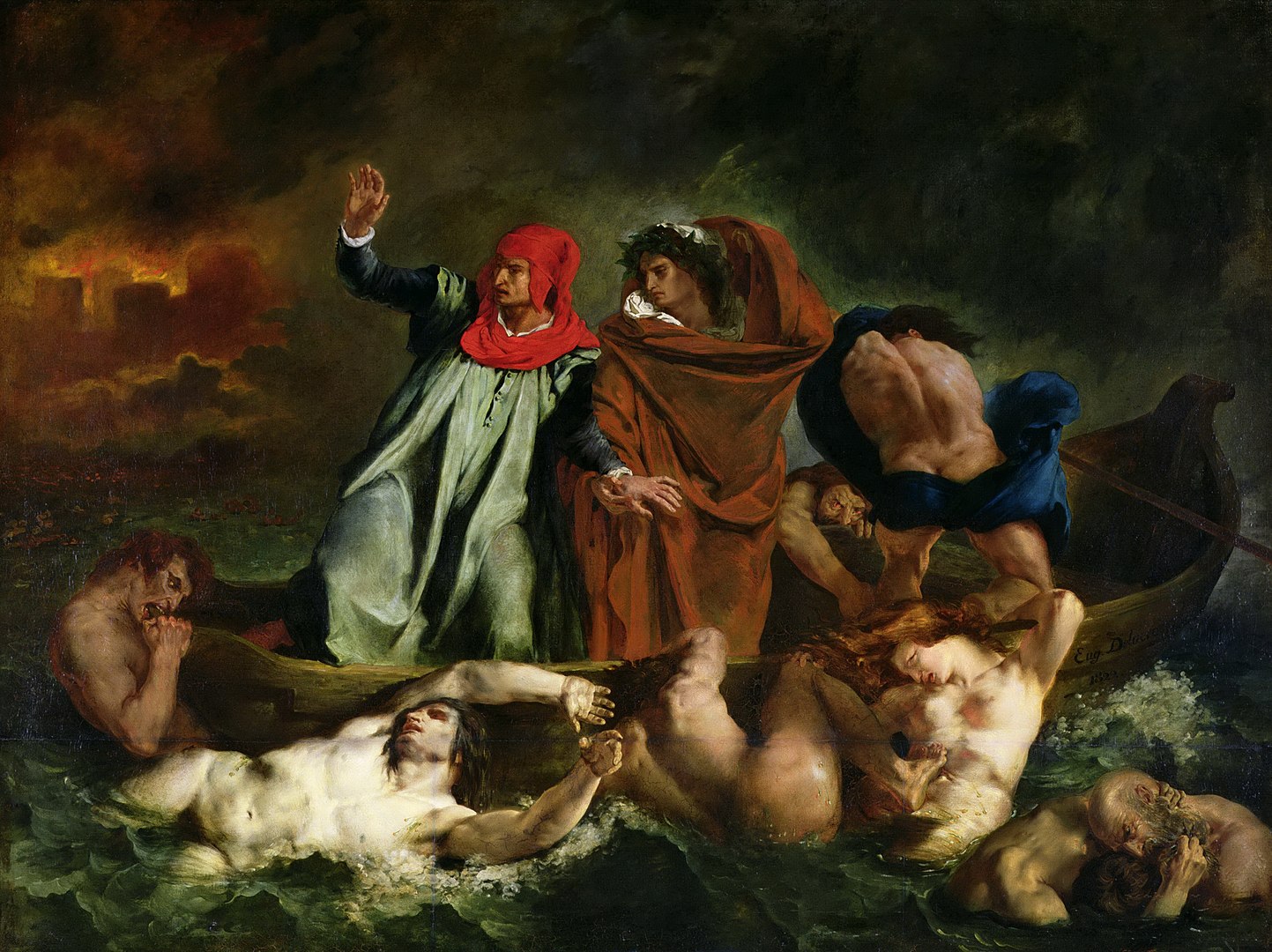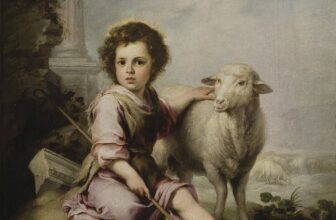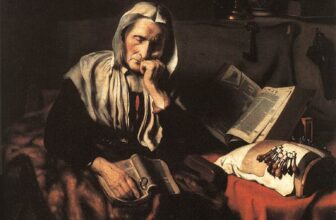
The Barque of Dante: A Journey into the Flames of the Inferno
In the heart of the Louvre Museum in Paris, among the galleries echoing with centuries of human creativity, there hangs a painting that seizes the viewer in a dramatic, otherworldly embrace. The Barque of Dante, with its fiery tones, stormy waters, and tormented souls, is more than just a stunning example of Romanticism, it’s a window into the imagination of a literary and artistic genius. This masterpiece marks a pivotal moment in the history of French painting and serves as an homage to literature, mythology, and the eternal struggle between good and evil.
Who painted this gripping work? What story does it tell? And who are the anguished figures depicted within its tempestuous frame?
Who Painted The Barque of Dante?
The Barque of Dante, also known as Dante and Virgil in Hell, was painted by Eugène Delacroix in 1822. This work was Delacroix’s first major painting, created when he was just 24 years old. It marked his debut at the Paris Salon, France’s premier art exhibition, and it signaled the emergence of a powerful new voice in Romantic art.
Delacroix was deeply influenced by literature, particularly the classics, and his inspiration for this painting came from The Divine Comedy, the 14th-century epic poem by Dante Alighieri. The section that inspired Delacroix comes from the Inferno, where Dante journeys through Hell guided by the Roman poet Virgil.
Delacroix’s innovative use of color, emotion, and movement in this painting won both acclaim and criticism in its time. Today, it is considered a foundational work of the French Romantic movement, setting the stage for his later masterpieces and cementing his place in the pantheon of great artists.
What Is The Barque of Dante Painting About?
To understand this painting, we must first understand its literary roots. In Inferno, the first canticle of The Divine Comedy, Dante journeys through Hell as a pilgrim, witnessing the fates of the damned. In Canto VIII, he and his guide Virgil must cross the River Styx, which separates the fifth circle of Hell from the sixth.
This river is filled with the wrathful, souls who were consumed by anger in life. These spirits thrash and fight in the water, eternally reenacting their rage.
Delacroix’s painting captures this moment: Dante and Virgil are aboard a boat, ferried by the demonic figure Phlegyas, as they make their way across the infernal river. Around them, the damned writhe in agony, grasping at the boat and the passengers within. Flames burn in the distance, signifying the City of Dis, the fortress of Hell’s lower circles.
It’s a moment of high drama, dread, and existential horror, and Delacroix renders it with breathtaking intensity.
What Is Happening in The Barque of Dante?
The scene is one of chaos and terror. The small boat is tossed upon dark, churning waters. The figures within are caught in varying emotional states, determination, horror, rage, and sorrow.
At the heart of the composition:
Dante, dressed in a red robe, appears overwhelmed and frightened. He clings tightly to Virgil, struggling to maintain his balance amid the turmoil. This is Dante the pilgrim, not yet the wise poet, experiencing the infernal world for the first time.
Virgil, in contrast, remains composed. Draped in a blue toga-like garment, he gazes forward with grim determination, guiding Dante through Hell’s horrors with stoic resolve.
Phlegyas, the infernal ferryman, is a muscular, contorted figure at the front of the boat. His mouth is open in a scream or shout, and he appears to be directing the vessel with feral energy.
Around the boat, naked souls of the damned claw at the edges, trying to escape their eternal torment or drag the living down with them. Their bodies are twisted in pain, faces contorted in anguish. These are the wrathful, forever immersed in rage, now punished by their own unrelenting fury.
In the background, through a haze of smoke and fire, we see the burning city of Dis, its flames leaping toward the dark heavens. The smoke seems to blend with the turbulent sky, adding to the sense of doom and eternal suffering.
Delacroix fills the canvas with contrasts, fire and water, light and darkness, calm and chaos. The emotional weight is heavy, almost suffocating, yet mesmerizing. It is a masterpiece of dynamic composition, psychological intensity, and symbolic richness.
Who Are the People in The Barque of Dante?
Let’s explore the main figures in greater depth:
1. Dante Alighieri
Identity: The central character of The Divine Comedy, Dante is both the author and the protagonist of the story. In this scene, he is a pilgrim, still mortal, still learning.
Appearance: He wears a long red robe, symbolic of his humanity, passion, and vulnerability.
Expression: Dante appears overwhelmed, even frightened, as he sees the tortured souls of Hell. He grips Virgil’s robe, seeking guidance and protection.
Symbolism: Dante represents the soul’s journey through ignorance and sin toward enlightenment and salvation.
2. Virgil
Identity: The Roman poet who guides Dante through Hell and Purgatory. In the poem, Virgil symbolizes reason and classical wisdom.
Appearance: He wears a pale blue or white garment and stands with dignified calm, unshaken by the chaos around him.
Expression: His face is stern but calm, embodying rationality and inner strength.
Symbolism: Virgil is the voice of reason amid emotional chaos. He knows the infernal realms but is not ruled by them.
3. Phlegyas
Identity: In mythology, Phlegyas is the boatman who ferries souls across the River Styx. In Dante’s Inferno, he is full of rage, reflecting the wrathful souls he transports.
Appearance: Muscular, wild-eyed, and animalistic, Phlegyas is a demonic presence.
Symbolism: He represents uncontrolled anger and serves as both guide and tormentor.
4. The Damned Souls
Identity: These are the souls of the wrathful, condemned to the fifth circle of Hell.
Appearance: Naked and writhing, they reach for the boat with expressions of agony and desperation.
Symbolism: They embody unrelenting hatred and rage, the punishment for those who gave in to wrath during their lives.
Each figure in the painting tells part of the story, one of sin, consequence, and the soul’s perilous journey toward understanding.
Artistic Elements and Style
Delacroix’s painting is more than a literal illustration of Dante’s text, it’s an emotional landscape, rendered through dramatic composition and vivid color.
Color and Light
The palette is dominated by deep reds, oranges, blacks, and cool blues. The fire of Hell casts an eerie glow on the water and the figures, contrasting with the pale skin of the damned. The water is a sickly green-blue, turbulent and unnatural.
Movement
Every line in the painting suggests motion: the waves churn, the figures twist and reach, the flames leap. The boat itself is at an angle, suggesting instability. This constant motion evokes the chaos and emotional upheaval of the scene.
Romanticism
Delacroix was a pioneer of Romantic art, which emphasized emotion, drama, and the sublime. Unlike the calm order of Neoclassicism, Romanticism thrived on tension and the supernatural. The Barque of Dante is an early and powerful expression of that movement.
Where Is The Barque of Dante in the Louvre?
Today, The Barque of Dante hangs in the Louvre Museum in Paris, France. Specifically, it is located in the Denon Wing, among the collection of 19th-century French paintings. Visitors can find it in the Romanticism section, where it is displayed alongside works by Delacroix and his contemporaries.
Its accession number in the Louvre’s collection is INV. 5417.
The painting is relatively large, measuring approximately 1.89 meters x 2.41 meters (about 6.2 ft x 7.9 ft). Its scale adds to its immersive quality, standing before it, one feels almost pulled into the river, into Hell itself.
The Louvre labels it as a masterpiece of early Romantic painting, and it is considered one of the museum’s essential works to see, alongside the Mona Lisa and Liberty Leading the People (also by Delacroix).
Legacy and Influence
The Barque of Dante was met with mixed reviews at the time of its exhibition in 1822. Some critics praised its boldness and emotion, while others derided its unconventional style. But its impact was undeniable.
For Delacroix, it was the beginning of a storied career. He would go on to paint works such as Liberty Leading the People and The Death of Sardanapalus, becoming one of the most important artists of the 19th century.
The painting also influenced other artists and writers. The emotional intensity, literary foundation, and vivid imagination became hallmarks of Romanticism not just in painting, but in literature and music as well.
In modern times, The Barque of Dante continues to captivate viewers. It is a reminder of the power of art to transcend time and medium, to bring literature to life, and to express the deepest fears and hopes of the human soul.
The Barque of Dante is a visual manifestation of one of the greatest literary journeys ever written. Through the eyes of Delacroix, we see Dante’s descent into the horrors of Hell, not as a distant allegory, but as a visceral, immediate reality.
We witness fear in Dante, wisdom in Virgil, rage in Phlegyas, and torment in the damned. We feel the heat of the flames, the churn of the water, and the pull of the abyss.
Eugène Delacroix’s genius lies in his ability to take a moment from a 14th-century poem and turn it into a timeless tableau, a work of art that continues to speak to the soul, centuries later.
Next time you find yourself in the Louvre, pause before The Barque of Dante. Step into the boat. Feel the storm. And let yourself be guided, like Dante, through the passions and perils of the human condition.




